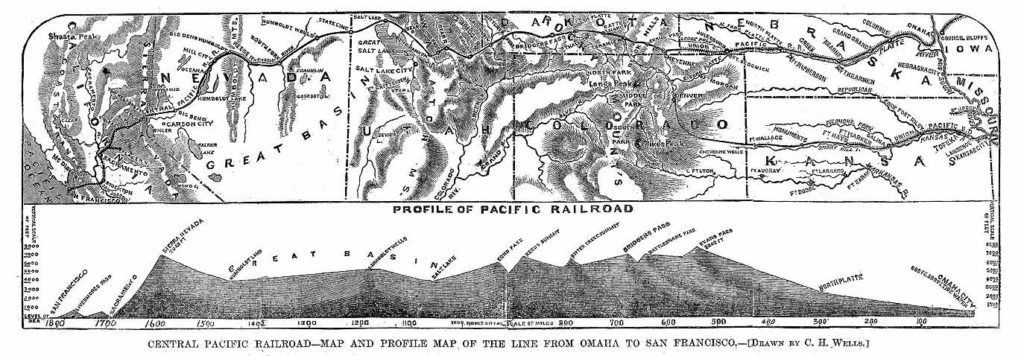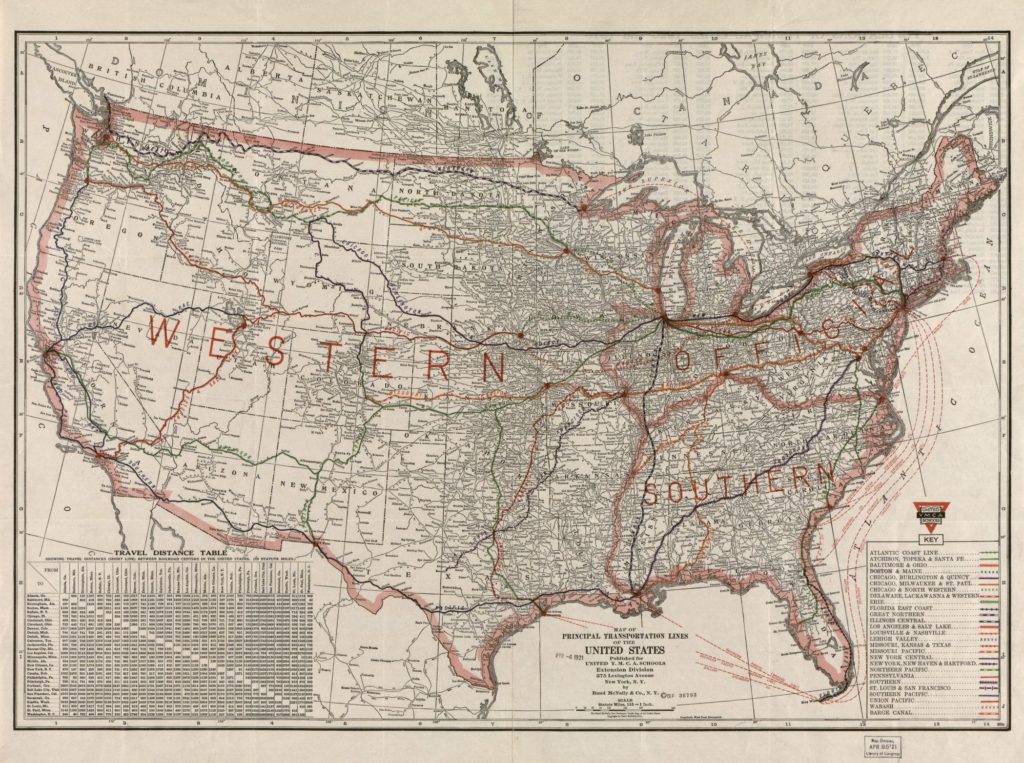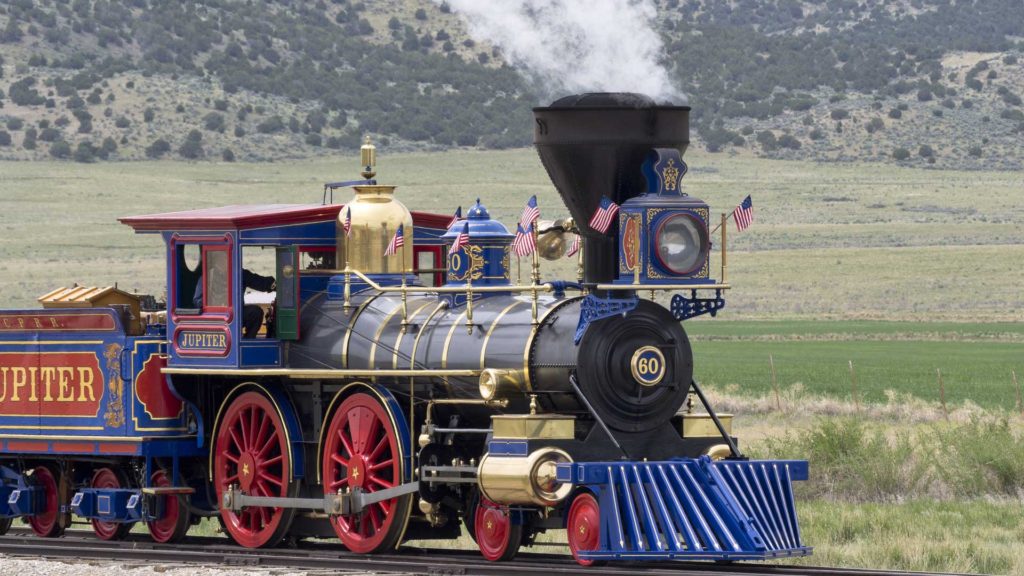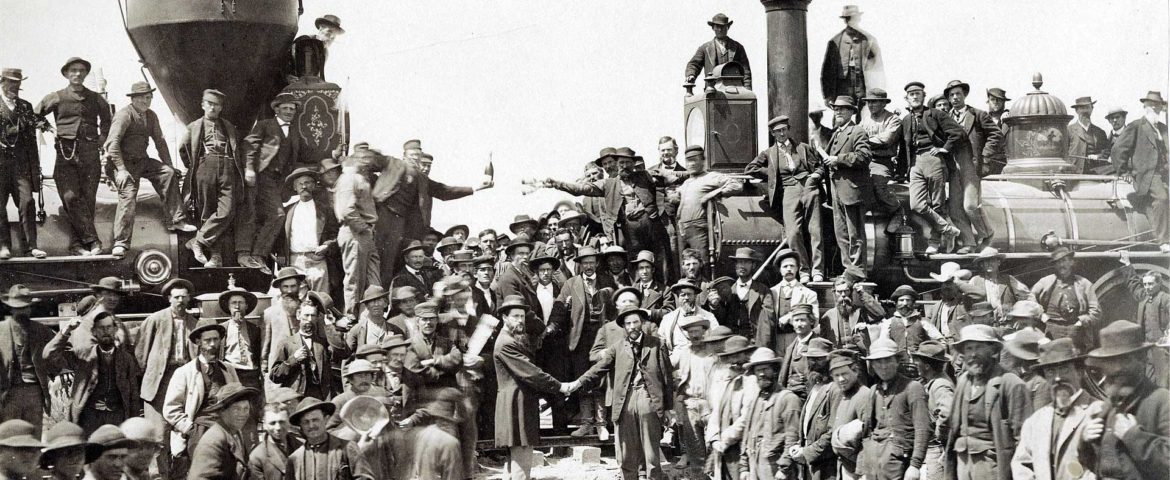Today, May 10th marks the 152nd anniversary of the completion of the transcontinental railroad, which was a landmark event that’s hard to overstate the importance of. While today It’s hard to imagine how critical the event was, keep in mind cars and planes had not been invented and the only way to travel overland was either by train or horse.
The first transcontinental railroad was a 1,912 mile-long rail line that was built over 6 years and completed in 1869, connecting the Midwest with the west coast via a newly built route from Iowa to Sacramento, California.
The rail line was a strategic milestone for the growing country and opened up freight and passenger movement to the west, and was largely credited with opening up the west coast to the rest of the country and providing the infrastructure necessary for the western states, including California to prosper and grow.
Transcontinental Railroad Origins
Early ideas for the railroad originated as early as 1847 with a proposal to Congress. Nearly 400,000 square miles were surveyed in an effort to plan the route.
A little-known fact is that early planning for the railroad determined that route through Arizona and New Mexico would be the most feasible route, which was a major factor behind the US’s decision to make the Gadsden Purchase, which was a major land purchase from Mexico.

There was much debate over what route the first transcontinental railroad should take, whether southern, central, or northern, with each having proponents as well as its own advantages and disadvantages. Amazingly one of the reasons that Council Bluff, Iowa was chosen as the eastern terminus where the railroad would connect with the existing US rail network was that at the time, the Civil War was raging, and keeping the terminal in Iowa, kept the rail line a satisfactory distance away from any actual fighting.
Construction of the Transcontinental Railroad
It took a literal act of congress, in the midst of the Civil War to bring about the legislature necessary to fund the railroad. Government bonds were issued and the railroads would be $16,000 per mile of level track laid, ( nearly $455,000 in today’s money), and $48,000 per mile laid in the mountains.
The Union Pacific and Central Pacific railroads were created and backed by private investors to build the actual railroad lines. Land grants were also critical to the railroads’ ability to generate business and successfully develop and fund the build. Many don’t realize it, but land grants to the CP and UP were nearly the size of Texas, over 180 million acres in total. In an effort to help promote city development the railroads sold land to settlers and others around cities.
The actual construction of the railroad was a major undertaking and feat of engineering. Since there wasn’t a good way to get equipment to the western starting point in Sacramento, materials including railway locomotives, track and machinery were moved by boat to west coast ports.
Telegraph lines were built along the railroads to communicate with these telegraph lines eventually becoming the first transcontinental telegraph system.
Many present-day towns were founded during the construction of the railroad, including Laramie and Cheyenne.
Many laborers on the railroad were veterans of both Armies of the Civil War, in addition to many thousand Chinese workers. Keep in mind that large power equipment hadn’t been invented and most of the work was done with hand tools.

Massive obstacles such as rivers, and mountains proved extreme challenges as they required tunnels, vast excavation work, or building massive bridges. As the rail line progressed, trains brought construction materials up to the active work sites. Dangerous blasting techniques were used to tunnel through mountains and create cuts. As construction moved into the Rocky Mountains, winter conditions became a major obstacle and resulted in the deaths of workers. The section of track between Reno Nevada and Sacramento was especially difficult due to the winter conditions. Even today, modern railroads use snow sheds to control avalanches across the line.
Since the Panama Canal had not been built, supplies headed to the Central Pacific traveled nearly 18,000 miles over 200 days around the Cape of Good Hope.
The line was finally completed after six years of construction in Promontory Summit, Utah, where the famous photos were taken of the gold spike being driven. The event was celebrated across the country with nearly every newspaper carry photos and a story of the event.
Following the completion of the railroad line, many other off-shooting tracks were built and the western railroad network expanded greatly in the following years. The route was also refined with better track infrastructure, bridges, and just in general was improved massively over the original track. Keep in mind that speed of important, so often the longevity of the original track laid was secondary to it simply being finished.
Early passenger trains took around 83 hours to traverse the line from New York to San Francisco. It might seem like a large amount of time today, but prior to the completion of the railroad, this trip would have taken months via horse or even taking a ship going around South America.
Building America
A building boom ensued following the completion of the railroad, with people and businesses expanding westward in a rapid fashion. Railroads were what Apple and Tesla are today and hundreds of railroads were started and financed in the mid to late 19th-century building thousands of miles of track across the country.

Following the completion of this first transcontinental railroad, other transcontinental railroads were built south and north of the original route. The Santa Fe built a line from Kansas to Los Angeles through New Mexico, the SP built a line from New Orleans to Los Angeles. Then the Great Northern and Northern Pacific Railroads were built linking Chicago to Seattle and the Pacific Northwest.
It was around the time of the first transcontinental railroad’s construction that time zones were created. Learn more about why time zones were created HERE.
The Transcontinental Railroad today
Several transcontinental rail routes are operated today by multiple railroads. The original route, known as the Overland Route is operated by the Union Pacific. UP continues to run between 50-100 trains daily across their Overland route carrying millions of tons of cargo annually. Each train of cargo would require around 200-400 trucks to move the same volume of freight.
Intermodal freight is an important type of cargo moved by the railroads across transcontinental routes. Intermodal is the use of containers hauled by truck for the first and last mile of the journey then rail for the long haul portion of the trip. Being around 75% more efficient the trucking and 10-25% less costly, intermodal is an important and growing form of full truckload transportation that gives customers that don’t have a direct rail connection to their building the ability to access the efficiencies of railroad transportation. Millions and millions of intermodal containers are moved, both from domestic locations and international intermodal containers coming off cargo ships across transcontinental cross-country freight lanes.
Modern railroads continue to invest heavily in their transcontinental routes with class 1 carriers spending literally billions annually to improve and repair their infrastructure while expanding their cargo-carrying capacity.
US railroads today operate on 140,000 miles of track, generate $80 billion in revenue while providing over 160,000 jobs. US freight railroads move around 28% of all cargo moved, while heavy bulk commodities like coal, lumber, grain, etc are great fits for the bulk haul abilities of trains.
Transcontinental Railway Locomotives

The first steam locomotives on the transcontinental railroad were relatively crude and small even for steam locomotive standards. Developing less than 500 horsepower and only able to pull around 100 tons of freight depending on the grade, nonetheless, they were engineering marvels for their time.
The two famous locomotives in the photos of the actual event were Union Pacific 119, and the Central Pacific “ Jupiter”. UP 119 was built in 1868 and eventually scrapped in 1903. The CP Jupiter was also built-in 1868 and scrapped.
In the late 1970s, the US park service decided to build replicas for their national historic site. The locomotives were built from original drawings and are mechanically identical to the originals.
Basic mechanical dimensions of the UP 119 include a boiler operating pressure of 120 psi, around 290 hp, 3.36 tons of coal capacity and 2,000 gallons of water. The locomotive was 41 ft long and weighed 65,000 lbs.
Steam power evolved through the years and was eventually replaced by diesel-electric power in the mid-1950s. Modern diesel locomotives use V12 or V16 diesel motors to generate 4,500 hp and produce well over 120,000 lbs of tractive effort. Multiple locomotives can be controlled throughout the train from the lead unit and traction, braking and other systems are all microprocessor controlled.
Visit the Golden Spike site
The national park service has created a living museum and historic site in Utah where you can experience the golden spike ceremony with reproduction steam locomotives.
Check them out here: https://www.nps.gov/gosp/index.htm
Zmodal is a top intermodal shipping company providing door-to-door intermodal, and full truckload services nationwide throughout our digital supply chain dashboard which provides easy route searching, booking, document management, and analytics. CONTACT US if you want to lower your supply chain costs or want access to North American intermodal capacity.
Recommended for further reading:
https://en.wikipedia.org/wiki/Union_Pacific_No._119
https://en.wikipedia.org/wiki/First_transcontinental_railroad
https://railroads.dot.gov/rail-network-development/freight-rail-overview



